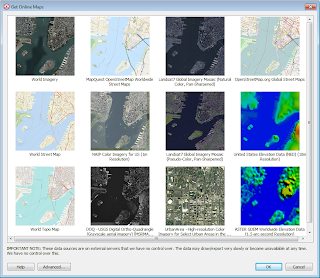A new image object type which we are calling a "raster" has been added with GMS 9.0. Rasters are essentially images with elevations - an image that includes a color value and a data value at each pixel. GMS uses the raster object type to support DEM files, and a large variety of DEM file types can be imported into GMS as rasters.
Rasters can be displayed as 2D images, with or without shadows, or as a 3D point cloud without shadows. Both options are very fast and memory efficient. Four different shaders, or color ramps, can be used to show variations in elevation.
Rasters can be interpolated to all other GMS object types as well as to MODFLOW layer data (similar to 2D scatter points). They can be created inside GMS from 2D scatter points.
A wiki page has been created to document the raster interface in GMS and a new Raster tutorial will be available when GMS 9.0 is released.
Updates on what's happening with GMS development.
Wednesday, October 24, 2012
Friday, October 12, 2012
Online Maps
"Online maps" are a new feature added at GMS 9.0. Online maps are free raster data (aerial photos, street maps, elevation data etc.) from sources such as ESRI and OpenStreetMap.org (other sources can be added via an Advanced button). If you have an internet connection, online maps can be displayed in the background in GMS and are updated automatically as you zoom in and out or pan the view. The imagery is automatically projected to the current display projection and displayed in real world coordinates. An online map can be exported and saved locally with your project.
Online maps provide an easy way to locate and start a new modeling project. For more information, see the wiki.
Online maps provide an easy way to locate and start a new modeling project. For more information, see the wiki.
 |
| Get Online Maps dialog. |
 |
| GMS showing a World Topo Map Online Map. |
 |
| GMS showing a World Imagery Online Map. |
Monday, October 1, 2012
September 2012 Sprint Highlights
Some of the more interesting accomplishments from the September 2012 sprint:
- Fixed over 18 bugs
- Changed the Virtual Earth Locator tool to start where the graphics windows is currently
- Project-on-the-fly finished except for tutorial
- Rasters finished. Added display of elevation under mouse, exporting of more formats, legend fixes, local (non-global) projections, 3D point cloud display
- Horizons -> Solids using rasters implemented
- Added node xyz coordinates to arc attribute table
- Progress on Wiki -> Help
- GMS 9.0 beta ready
- MODFLOW-LGR HDF5 conversion done
- MODFLOW version, precision, parallel options saved in super file
GMS Now Includes Support for the PCGN Solver
GMS 9.0 includes support for the PCGN solver (Preconditioned Conjugate Gradient Solver with Improved Nonlinear Control). The PCGN solver is included in MODFLOW-2005. The PCGN solver was created to provide more options for models with poorly converging non-linear problems. A detailed description of recommended PCGN input values can be found in the USGS Online Guide to MODFLOW.
The PCGN solver has been parallelized and can result in faster model runs for large models when the MODFLOW Parallel preference is enabled in the GMS Preferences dialog.
The PCGN solver has been parallelized and can result in faster model runs for large models when the MODFLOW Parallel preference is enabled in the GMS Preferences dialog.
Subscribe to:
Comments (Atom)


